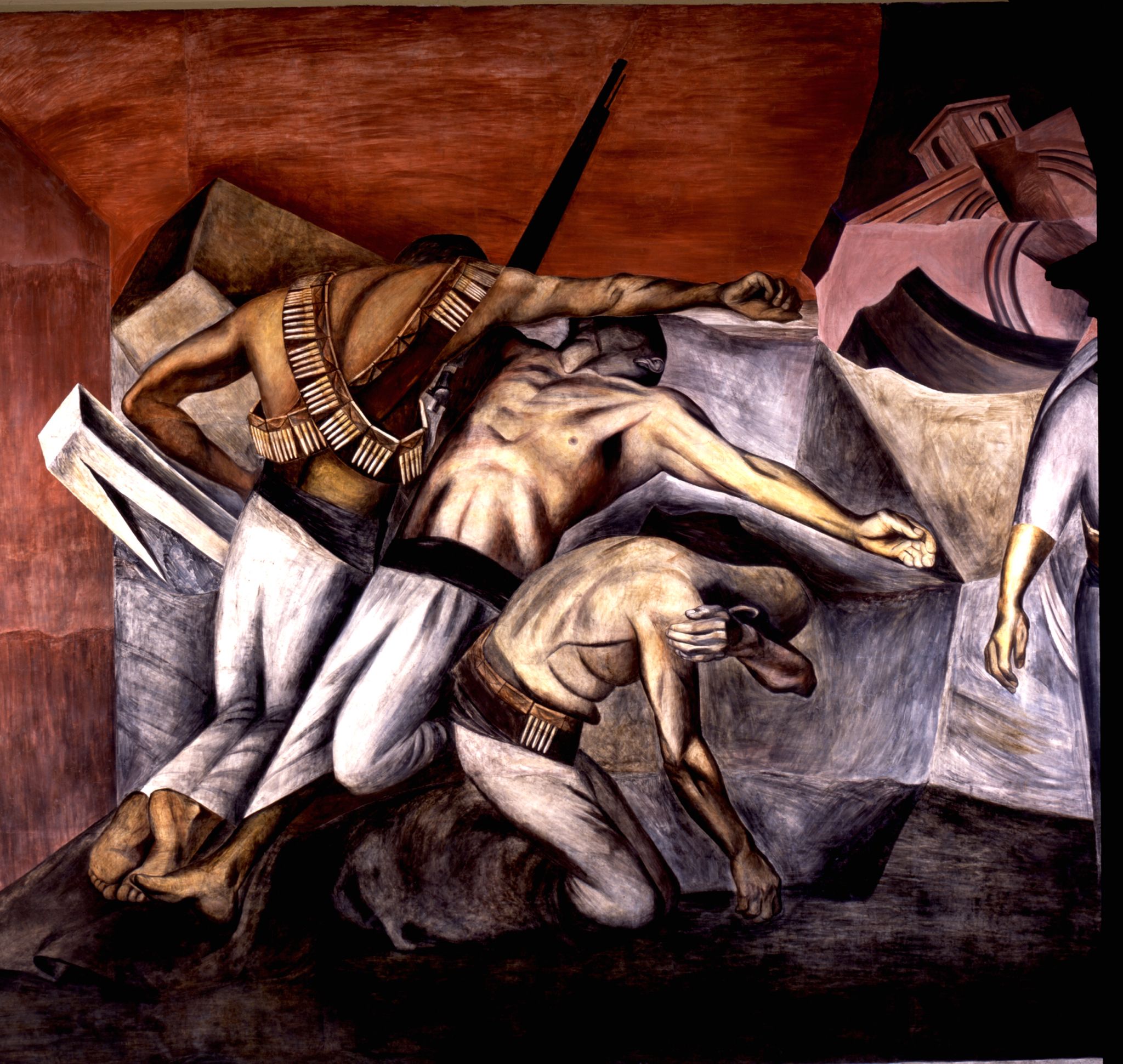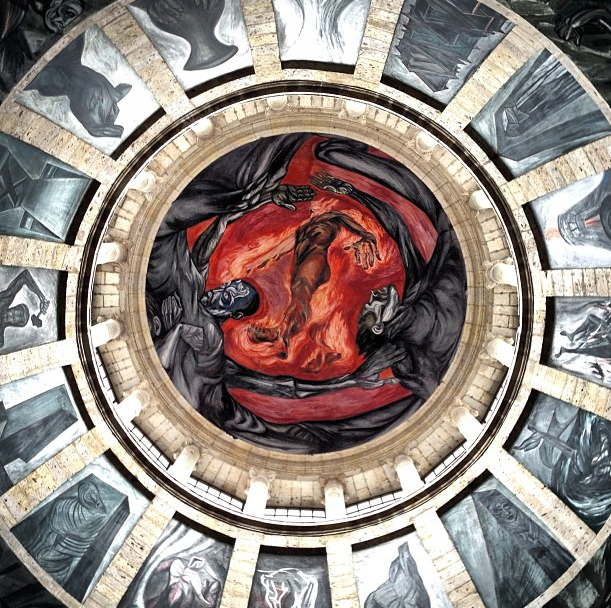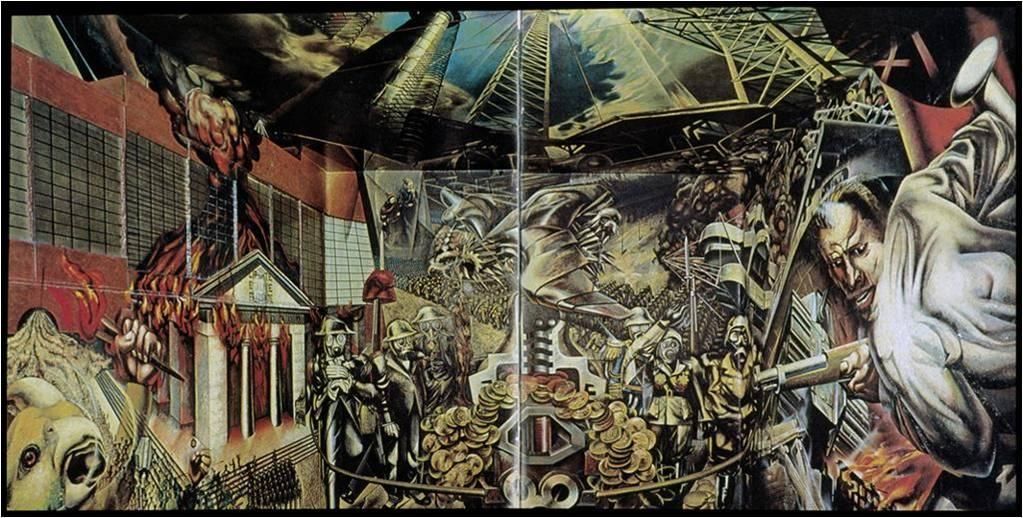
Artist: Diego Rivera
Title: La historia de México
Date: 1929 – 1935
Label: Depicted is the large mural Diego Rivera made to portray the history of Mexico. The three panels all come together at the bottom where pre-colonial Mexico is shown to illustrate Mexico’s indigenous roots and the wars and oppression they have been through. This was made to build a sense of pride for all Mexicans and to represent native people in a better light. Even though this is called The History of Mexico, there is also a part of the mural, specifically shown on the South Wall, where the artist adds in an optimistic view of the future of Mexico now that the revolution has come to a close.
Dimensions: covers three walls and some panels as big as 70 x 9 m
Medium: Fresco
Institutional Accreditation: National Palace, Mexico City, Mexico

Artist: Diego Rivera
Title: El hombre controlador del universo
Date: 1934
Label: Depicted here is a replica of the original work which was first commissioned to be placed in New York City’s Rockefeller Center. However it was taken down when the artist, Diego Rivera, added in depictions of communist leaders. This version of the mural allowed Rivera to complete the finished work without restrictions in revealing his own ideologies. In the center is a man who is surrounded by the world and its many perspectives. On each side of the man are different beliefs. On the right, Lenin, Marx, and Freidrich Engles, and on the left is Charles Darwin and John Rockefeller Jr. This artwork has become culturally significant to show the relationship between politics, the economy, and creative freedom.
Dimensions: 4,80 x 11,45 m
Medium: Fresco
Institutional Accreditation: Museo de Bellas Artes, Mexico City, Mexico

Artist: Fernando Leal
Title: Los Danzantes de Chalma
Date: 1922
Label: Displayed above is the artist’s rendition of a real event that had happened during that time. Leal had overheard that during a ritualistic dance that was meant to worship the Virgin Mary, her statue had fallen over, revealing a statue that was carved into the wall of the native Mexican goddess of water, which had previously been hidden. Although Fernando Leal did not receive the same amount of fame as “The Big Three”, he was one of the first to start off this movement, and bring indigenous Mexican culture into the limelight.
Dimensions: N/A
Medium: Fresco
Institutional Accreditation: San Ildefonso College, Mexico City, Mexico

Artist: Jose Clemente Orozco
Title: The Trench
Date: 1926
Label: Depicted above are soldiers in the Mexican Revolution in a very somber presentation. While other artists focused on the hope the future after the war promised, Orozco was actually in Mexico during the war and saw all the struggles and fighting the people Mexico had to face. Orozco focused on the body language of the men in the mural, making sure that their sorrow, vulnerability, and suffering can be felt through the art. For many, Jose Clement Orozco was able to put humanity back into those affected by the war unto the public eye.
Dimensions: 4 x 2 m
Medium: Fresco
Institutional Accreditation: Museum of Modern Art, New York, New York

Artist: Jose Clemente Orozco
Title: El hombre en llamas
Date: 1939
Label: Depicted above is the fresco also known as “The Man of Fire”, in this surrounded by a series of arched panels, a self-sacrificing man is in the center of it all. Orozco was surrounded by the horrors of the world throughout his entire life and in this mural, we see his version of a glimmer of hope. Represented in this fresco is Mexico’s struggle with both indigenous and European forces, and trying to find a middle ground between it all.
Dimensions: 27 m
Medium: Fresco
Institutional Accreditation: Hospicio Cabanas, Guadalajara, Mexico

Artist: Aurora Reyes Flores
Title: Atentado a los Maestros Rurales
Date: 1936
Label: Illustrated above is a woman being taken from her children as the title shows, an attack on rural teachers. This was made to portray how capitalism was the root of brutality in Mexico and how things like education and the youth, were being betrayed. Here you can see a book being torn while the woman is dragged unwillingly. The children watch on from a hidden place and in the center, a gun is being held by a faceless man to portray the larger picture of violence being spread throughout Mexico.
Dimensions: 4 x 2 m
Medium: Fresco
Institutional Accreditation: Centro Escolar Revolucion, Chihuahua, Mexico

Artist: David Alfaro Siqueiros
Title: Birth of Fascism
Date: 1936
Label: Shown above is a woman giving birth to a monster which represents fascism in this painting. Although known for his murals, Siqueiros also created many paintings during the Mexican Muralism movement. The woman depicted is said to be a whore who is having a painful birth to a monster during a storm who wishes to be saved. To have such an ominous and painful painting be called the “birth”, it sends a very clear message of his political beliefs to the viewer.
Dimensions: 75 x 65 cm
Medium: pyroxylin on masonite
Institutional Accreditation: Sala de Arte Publico Siqueiros, Mexico

Artist: David Alfaro Siqueiros
Title: Portrait of the Bourgeoisie
Date: 1939
Label: Illustrated above was David Alfaro Siqueiros’ warning to the people of the dangers of intersecting the government, capitalism, and industry. On the left, we see the burning buildings that represent the order of the past while the rest of the walls depict his fears of nature and machine intertwining.In Marxist contexts, the bourgeoisie is the class who owns most of society’s wealth and means of production, this mural portrays the artists’ concerns with how society will unravel if they continue to be the ones in power and the lower classes are continued to be ignored.
Dimensions: 92 m
Medium: Fresco
Institutional Accreditation: Electrical Workers Union Building, Mexico City, Mexico


